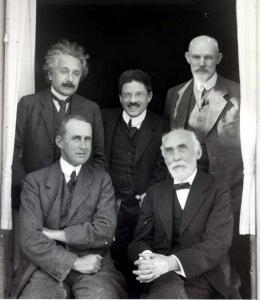
WASHINGTON — Einstein’s latest success was announced to great fanfare recently. The gravitational waves he predicted over 100 years ago were detected by a huge collaboration at the Laser Interferometer Gravitational-Wave Observatory (LIGO.)
Although the new results are a triumph of science, the theory behind it is the product of complicated human relationships that played out against the backdrop of two world wars. Award-wining author and MIT professor David Kaiser took us back in time during his Feb. 14 Sarton Memorial Lecture in the History and Philosophy of Science at the American Association for the Advancement of Science (AAAS) annual meeting. Kaiser said he was there “to embed [Einstein’s work on relativity] and the trajectory of ideas on a more human, and at times messy, world.”
While Einstein condensed the relation between the warping of spacetime’s geometry and the distribution of matter and energy into an equation short enough to tweet, Kaiser argued that it wasn’t entirely a solo effort. Einstein maintained correspondence with other great minds of his time who later helped him circulate his revolutionary ideas. Even before the theory was finalized, the brilliant physicist was already spreading a working knowledge to other academics. The flow of ideas did not cease as WWI broke out, but the war did limit where they flowed, as communication with Germany’s opponents was cut.
Still, the ideas found their way there. Einstein visited a neutral country, the Netherlands, and coached astronomer and mathematical physicist Willem de Sitter on relativity. Sitter was the perfect pupil. His neutral status allowed him to spread Einstein’s ideas to the allied nations — it was he who taught the English physicist Arthur Eddington about the theory. Eddington, being British, could not have direct contact with Einstein, but it was his observations that confirmed the theory of relativity.
“A British team seemingly confirming a German scientist’s prediction right on the heels of the Great War” made Einstein a household name, Kaiser said.
Despite the theory’s importance, the number of articles published on general relativity stayed quite small between the 1910s and the 1940s, and only began to rise sharply in the mid-to-late 1950s, Kaiser said. The rise of the Nazis was one of the factors that affected the theory’s popularity.
In the early 1930s a nationalist movement known as Deutsche Physik, formed within the German physics community, denounced general relativity. The core campaign to label Einstein’s theory “Jewish Physics” was led by two physics Nobel laureates, Johannes Stark and Philipp Lenard. As the Nazis gained power, the campaign accelerated and Lenard published pamphlets and gave lectures knocking Einstein’s theory. Eventually, in 1933, Lenard wrote a book that tried to prove that every major scientific advance in history had come from racially pure or Aryan people.
The general relativity theory seemed to be going nowhere — until the mid-to-late 1950s, when the number of published papers escalated exponentially. The sudden surge in popularity had to do in part with new astronomical discoveries, new technologies, and new support for research in the field.
One of the new technologies was military: the theory was used to predict the trajectory of intercontinental ballistic missiles. Around the same time, American theoretical physicist Bryce DeWitt was tasked with the computer simulation of H-bombs, a feat he achieved by analyzing the problem in a relativistic way. DeWitt went on to jumpstart the study of gravitation on a computer. The approach worked for simulating the collapse of massive objects, like black holes, making him a pioneer of numerical relativity.
Coming full circle, breakthroughs in numerical relativity and a deeper understanding of black holes were essential to the gravitational wave discovery. Scientists were able to model the merger of two black holes and accurately predict the form of the resulting gravitational waves, giving us new eyes on the cosmos.
Laura M. Olivieri is a senior at the Universidad de Puerto Rico-Recinto de Mayagüez majoring in physics. Her work has been published in Science and HerCampus-UPRM. You can reach her at laura.olivieri24@gmail.com but she’s also a social media enthusiast so give her a shout-out on Twitter @esteledeperfume.



